O-ring

The O-ring is the most versatile packing element:
- It is self-packing, simple, does not require big space,
- It features double-action packing,
- It is simple to install,
- It is used both in static and dynamic applications - it prevents undesirable liquid leak or loss; this, however, being influenced by selection of a correct installation and material.
Drawing:

Dimensions:
The O-ring's size is defined by the d1 inside diameter and by the ring's d2 thickness.
O- ring's ø d1 x d2
When specifying the O- ring's cross-section it is suitable to select the biggest cross-section, which is possible for a given case, as regards design.
The installation space dimensions must meet the following conditions:
- Permissible elongation of the d1 inside diameter is 6 % (exceptionally 8 %) and its permissible depression is 3 % (exceptionally 4 %);
- Upon packing of fixed parts, the d2 diameter must be reduced at least by 10 %, for packing axially moving parts at least by 6 %. Maximum permissible compression is 25 %.
Radial installation (static and dynamic)
On sealing by inside diameter it is recommended to select such O-ring size so as the difference of the d1 inside diameter and of the d4 tight diameter be as low as possible. On sealing by outside diameter it is suitable to select such O-ring size so as the d1 inside diameter be equal to or smaller than the d3 groove diameter.
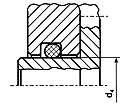
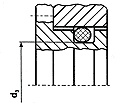
Axial installation (static)
In the case of the O-ring's installation, considered should be first of all the direction of the pressure incidence. On application with inside pressure it is suitable that the O-ring's dimensions be by 1 to 2 % higher than the d5 groove diameter. For packing of inside pressure the O-ring is designed by 1 to 3 % smaller than the inside diameter of the d6 groove.
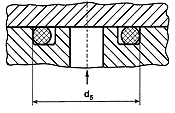
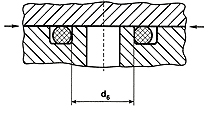
Specification of materials:
| Material | Temperature range | Usage | Hardness |
|---|---|---|---|
| NBR Acrylnitrile-Butadiene-Rubber |
- 30 °C + 110 °C | standart material for hydraulic and pneumatic
compression fluid on mineral-oil base animal and vegetable oils heavily inflame fluids, aliphatic hydrocarbons (propane,butane,gas) silicon oils water up to +80°C, air, bio-oils, from synthetic ester and vegetable oils |
60 - 90 |
| EPDM Ethylene-Propylene-Dien-Rubber |
- 60 °C + 150 °C | hot water, vapour, brake fluid, washing means alcohols, ketones, KFZ-cold water heavily inflame fluids on the phosphorus-acid base organic and anorganic acids and bases | 70 |
| Silicone | - 70 °C + 230 ° | hot air, oxygen, ozone, UV-rays aliphatic engine and transmission oils, animal and vegetable oils brake fluids | 70 |
| FPM Fluorine-Rubber |
- 20 °C + 260 °C | mineral oils aliphatic, aromatic and chlorine hydrocarbons gas, super-gas, diesel-propellants heavily inflame fluids on phosphate-ester base, silicon oils acids, lyes | 80 |
| AU Polyurethane |
- 25 °C + 80 °C |
mineral hydraulic oils mineral engine and transmission oils gas, diesel aliphatic hydrocarbons and air |
90 |
O-ring hardness
- It is determined in particular in accordance with the height of operation pressure and dimension of packed groove,
- For high pressure and big seam harder materials are selected so as to prevent it from being impressed into the seam.
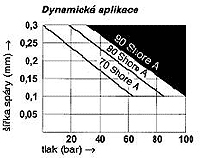

Classification of O-rings in accordance with their application
Static sealing
Static sealing is of such a kind where mutually packed parts do not move.
- Sealing under screw-head
- Sealing for pipe joints
- sealing of lids
Dynamic sealing
In the case of a moving sealing, mutually packed parts move axially, helically, oscillate, or rotate.
The most widespread use:
- hydraulic and pneumatic devices requiring small installation space
- for low strokes and relatively small diameters

